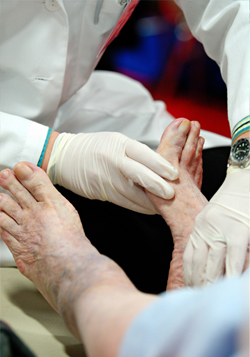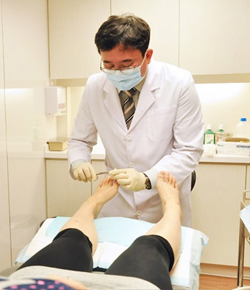Diabetic Foot Assessment and Management
Diabetes is a condition where you experience high levels of sugar in the blood, because the body is either unable to respond to it properly or does not produce enough.
Long term diabetes may lead to damaged nerves and poor circulation. Reduced sensation of the skin of feet is a common complication found in diabetes. The nerve that takes messages of sensation and pain are commonly affected. This means you may not be receiving messages about your foot injuries, to alert you that they need treatment, causing further damage. Injuries like simple blisters or cuts can cause major problems left unattended. These include the potential for wound infection, which can precede the requirement for amputation.
Another complication is narrowing of arteries. This caused a reduced blood supply to the feet. Skin with a poor blood supply do not heal as well as normal and is prone to infection.
A regular (every 6 months) foot assessment with your Podiatrist will assist in discovering any foot problems you may have not noticed early, before they become a major issue.
People who experience Diabetes - have an increased risk of having severe foot problems.
Diabetes is a serious condition which can have many effects on the feet, including:
-
Nerve damage, resulting in numbness, extensive burning, pain, coldness, "pins and needles" or tingling while at rest. These nerves may actually affect the "position" sense, so that the joints or bones actually collapse with time.
-
Blocked blood vessels or decreased blood flow with fewer nutrients reaching the feet. Without proper nourishment, sores on the foot may not heal in the normal time period, or may be vulnerable to secondary problems such as infection.
-
Weakened bones, causing a shift in the foot, which may become deformed, changing the way the foot distributes pressure.
-
Collapsed joints, especially in the area of the arch. As a result, the arch can no longer absorb pressure. The surrounding skin may also begin to break down.
-
Blisters and Calluses. Diabetics are much more vulnerable to blister or callus formation, which generally stars as a warm or red spot caused by unrelieved skin pressure and the failure of the diabetic to feel the area.
-
Ulcers or sores more easily occur as a result of the breakdown of several layers of skin. These ulcers may also become infected, and require a long time period to heal.
-
Wound and Bone Infection. The final manifestation of all this is a bone infection, where the breakdown of tissue goes all the way to the bone and secondary bone infection can occur, in some cases doctor will prescribe antibiotic or referral to relevant specialists for following up.
Diabetic Foot Care
Our routine diabetic foot assessment which involves checking pulses, capillary refill and skin temperature of the feet. Our podiatrist used dopplers and ankle-brachial index (ABI) test for checking the blood flow and the nerve function by testing the light touch, pressure, vibration senses and reflexes. We will check the general status of your feet and identify any risk factors such as corns, calluses, ingrown toenails and any at risk foot alignments/ shapes.
The routine diabetic foot treatment involves:
-
Regular nail care. Regular trimming or thinning of nails to prevent them from becoming thickened and ingrown.
-
Regular foot skin care. Treatment of calluses, corn and blisters so they do not ultimately become ulcers and infections. Our podiatrist can advise the specialised insole or footwear and specialised dressing for wound care.
-
Education. We also educate diabetics on a regular basis about the manifestations of decreased circulation, decreased nerve sensation, weakened bones and collapsed joints.
-
Examination. The patient is examined regularly for their feet and advise on proper footcare.
-
Customized footwear or foot orthotics. Custom shoes, insoles and devices can be custom made for diabetics in order to relieve pressure and pain to abnormal sensitive sites on the feet.

